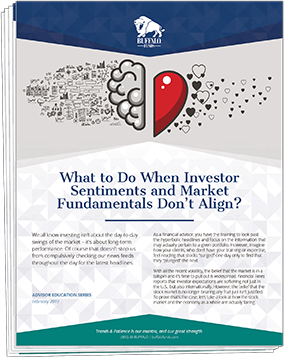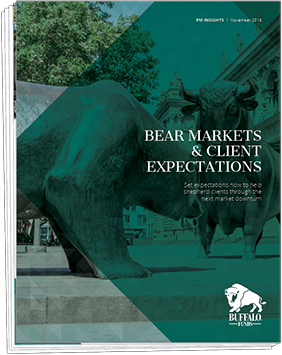Finding Your Voice: What Separates You From Other Advisors?
FINDING YOUR VOICE: WHAT SEPARATES YOU FROM OTHER ADVISORS?
When you’re fresh out of college or just learning your trade, it’s easy to hold onto the belief that if you just learn the right skills, then prospective clients will come to you for your services. In an ideal world, this could be true.
Unless your trade is so outrageously in demand that clients can’t afford to be picky — e.g., software engineering — then there’s going to be competition between those who provide that service that will leave at least some professionals with fewer clients — or even no business whatsoever.
Nowhere is this scarcity of clients more true than in the financial advisory world. Between the growing number of financial advisors and the limited number of investors seeking their services, competition between advisors is hearty, to say the least. Given these circumstances, it’s important to ask yourself, why should investors choose you?
To answer that question, you need to market yourself correctly. More specifically, you need a brand. An effective brand strategy will make it easy for your ideal clients to identify you among the sea of investment advisors eager to sign clients up for their services.
But how do you go about building a brand? Let’s first take a look at how people choose investment advisors.
- Results: You have to be able to deliver. In the context of investment advisory and wealth management, this means understanding and applying the principles of investing you have learned to grow your clients’ wealth consistently and responsibly. But this is just the bare minimum, and any other competent advisor can offer the exact same thing. Successful advisors also work hard to bring in clients by attending to at least these two other factors.
- Relationships: In highly technical fields where they have little basis on which to judge the quality of the work — think healthcare — people tend to rely on the recommendations of others. This phenomenon is amplified when people are out looking for investment advisors. After all, they’re not just going to hand over their money to a stranger. That’s why the investment advisor with more connections is the advisor more likely to bring in new clients.
- Trust: Trust is an important part of any transaction, but it’s going to be way more important as the nature of the business becomes more sensitive. Choosing an investment advisor to manage your life savings is naturally on the far end of that spectrum. That’s why referrals are so important to doing business as a financial advisor. But having good references isn’t always sufficient, nor is it the only way to encourage perspectives to trust you. To ensure the trust factor is there, you need to develop a brand identity and voice for yourself that inspires confidence in your target market.
Target Market
How do you know who your target market is? It can be somewhat arbitrary, to be sure — at a certain point you need to just pick a group because, try as you might, you can’t be all things to everybody. But to narrow down which markets you might want to target, think about your own personal values as an investor, as well as your professional strengths and who you tend to get along with best. Let’s say you’re younger, you’re flashier in your personal style, and you’re more aggressive in your investing strategy. In that case, you might want to go after the target market that most resembles your own personality — say, 25- to 35-year-old entrepreneurs and executives.
Branding
Once you’ve chosen your market, it’s time to codify your brand values, as well as the look and feel that you want people to associate with your practice. With regard to the former, you should compile these values into a coherent “about us” or statement of principles that you post online and can include in marketing materials so people know what you’re about. But more importantly, you should commit to following these principles in every business dealing and for every client. This is how you build integrity, a key factor in building trust.
The latter is called your brand identity, and it’s what most people think of when they hear the word “brand.” Your brand identity should reflect your values (i.e., honesty, integrity, accountability, clarity and ethics) and be appealing to your target market. There’s a lot of science and even more art to this process, so do yourself a favor and hire an experienced brand identity designer. And don’t make the mistake of thinking that brand identity is only for flashy startups and tech companies. Every brand, even a traditional one, can benefit from correct typesetting, composition and other design techniques.
After that, it’s all about getting your brand out there. That means organizing your business development activities around your brand. A couple of suggestions:
— Develop collateral and “swag” that’s relevant to your target market. If your target market is an older crowd, then a cool mobile-first web app and a branded phone case will never go as far as a high-quality, in-depth brochure.
— Get yourself to the right meetings, the right conferences, the right parties. Become an active member of the community that people know and recognize. And don’t just take, give back. Volunteer to help an organization with their finances; offer someone’s kid who’s interested in finance an internship. These kinds of actions show you’re a real member of the community, not just there hunting for clients.
These are the kind of thought patterns you need to get into if you don’t want to be just another investment advisor sitting around waiting for clients to come to you.
If there’s one thing to remember about branding, it’s that it only works if it’s consistent.
To reap all the rewards that branding has to offer, all your activities as an investment advisor should take into account the brand you’re trying to build. Do that and people won’t have any trouble telling you apart from the next advisor down the block.
Christopher Crawford is the Director of Advisor Relationships for the Buffalo Funds. He has 10 years of experience in the financial services industry, previously holding positions at Invesco, IMA Financial Group, and Arthur J. Gallagher. At the Buffalo Funds, Christopher works with investment consultant relations, key account management, institutional distribution and client service. His main goal is to partner with advisors to bring business building ideas and provide unparalleled customer support to their business, always striving to make it easy and reliable to work with the entire Buffalo Funds investment team. Christopher received an M.B.A. from Washington University in St. Louis and a B.S.F.A. from Southern Methodist University. He also holds licenses for the Series 7, Series 63, and Series 65.
 |
Christopher Crawford |







